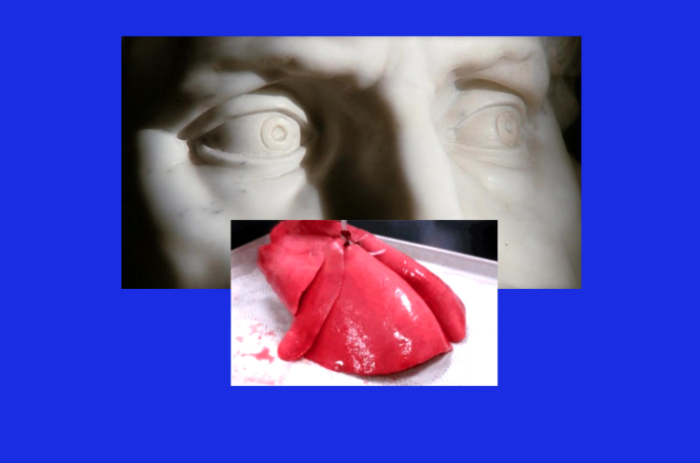|
Mis(sing)-Communication A six-week online screening programme curated by Tess Charnley |
 |
|
Kihlberg & Henry This Building, This Breath (2015)
|
|
For its first online
exhibition, the gallery presents a screening programme of video and
film works by Kihlberg & Henry; Neville Gabie; Oona Grimes; David
Cotterrell; Paulette Phillips; and Suky Best, curated by Tess Charnley.
This presentation will occur over the course of six weeks with a new
work made available for streaming each week. The works explore ideas
of spatial and bodily interiority and exteriority, solitude, communication
and the elasticity of time; topics that resonate in this time of altered
living (within and without our selves). They allude to the possibilities
of healing, as well as the complexities that arise with this repair.
For more information
on the artists and the work screened please click
here. |
|
Week One: Oona Grimes | u.e u.
20th - 26th April |
|
Oona Grimes u.e u. 2018 iphone and 16mm film duration: 9 mins 28 secs |
|
|
|
Week Two: David Cotterrell | Mirror III Horizon
27th April - 3rd May |
|
David Cotterrell Mirror III Horizon 2016 2
Channel HD Projection, Custom Morse Code Generators and iOs App
duration: 10 mins 06 secs HD video |
|
|
|
Week Three: Kihlberg & Henry | This Building,
This Breath 4th - 10th May |
|
Kihlberg & Henry This Building, This Breath 2015 |
|
‘The room has no clock, no window, no time. If the outside world were in free-fall you would not notice.’ This line from the voiceover seems particularly relevant now; we sit in isolation waiting for a future that is indefinable while time wears on, the trajectory of our lives thinning, confined by viral threat. When the countdown has ended and the minutes have passed, windowless buildings are projected on the screen while Roy Orbison’s House Without Windows plays, the music an unnerving but welcome anticlimax to the work’s stirring anxiety. The metronomic sound starts again and the work reverts to where it began, our vision wiped clean of what we have seen, an opportunity to start anew if we remain in these buildings, with our breath. Please note: The artists
recommend that the work is viewed full screen in a dark room, preferably
with no windows. |
|
Week Four: Neville Gabie | Experiments in Black and
White XXX 11th - 17th May |
|
Neville Gabie Experiments in Black and White XXX 2020 video
still drawing with black marker pen |
|
The work sees Gabie, suit-clad, step into the empty shoes, nailed to the floor. He creates a drawing, maximising the reach of his body’s span without moving from the shoes. He lies down when needs be, protracting the energy of his drawing, the energy of his body, as far as it will go. The work is a play in restriction. Gabie imposes limits on his range of movement, marking where his body can go with his pen, constraining his body as a reminder of the inches and metres between the range of bodies’ movements; how not all bodies can operate without effort, without assistance. Made during lockdown, the work is overlaid by a soundscape; field recordings of bird song combined with a recording of an MRI machine in operation. The rhythm of Gabie’s drawing, the pattern of its editing - flexing time - aligns with the MRI’s mechanical drone and clunk. We are reminded of the unseen hum of the NHS at this time, the birds that have become louder as planes vanish; the soundtrack to our confinement - rooted to the spot, mapping out the time of our limitation.
|
|
Week Five: Suky Best | The Sea House
18th - 24th May |
|
Suky Best The Sea House 2014 moving collage
with sound |
|
I watch this work on a countless day of COVID-19 induced self-isolation. Half an hour passes and I find that I have watched the work on loop, four times. There is something mesmeric about it, something soothing in a time of such high-anxiety. This is partially the magic of the sea, its healing qualities effective even through the transposition of its sound into a London flat, where in confinement I could not feel further from its salty sting. It is a metronome, marking the passing of time with its tides; with the soporific rumble of its body, retreating outwards and crashing inwards - dredging up and vanishing the grit from its bed, all in the same breath. The white noise of the sea underpinning Best’s collage draws us into the work’s imagery; lulls us into a rhythmic looking. At a time when many of us are facing empty rooms, we can take comfort in this work, rocked in our homes by the work’s lulling sounds. Please note: The artist recommends that the work is viewed on a continual loop. |
|
Week Six: Paulette Phillips | The Quoddy Fold
25th - 31st May |
|
Paulette Phillips The Quoddy Fold 2019 film |
|
|
|
>home |